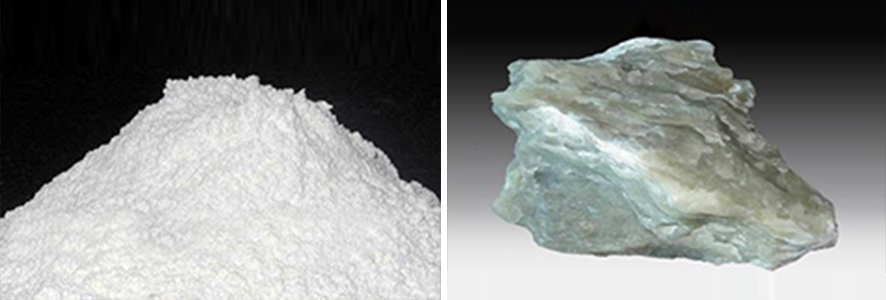Mineralogy and Geology
Talc is silicate and nucleation class belongs to the most common mineral. It through the local or contact deformation of dolomite deposit constitute, or by volcanic eruption, ultrabasic alkaline hydrothermal eruption rock weathering. In the deformation of rock, it is usually appear as secondary minerals.
Talc is also called cold stone - or its chemical terminology is hydrated magnesium silicate. It is the main element of the soap stone. The crystal often have large leaf polymers, with a thin sheet particles.
Talc is the softest mineral, Mohs hardness of 1. The silicate layer on another layer, only by the constraints of a weak force (residual van der Waals force). This makes it has characteristic of fatty or satiny feeling - so called "soap stone". In pure form, talc colorless or white color, usually with mother of pearl luster. If contain other ingredients, can also be displayed as light grey, green, yellow, or pink.
Associated minerals including actinolite, anthophyllite, calcite, chlorite, dolomite, pyroxene, serpentine, tremolite and vermiculite.
In the crystallization of naturally occurring, talc in magnesium can be replaced by the iron, aluminum, chromium and nickel.
Talc can absorb organic composition. And water opposites: talc insoluble in water, not dissolved. It also acid, chemical inertness and non-toxic. Talc without perfume.
The formation and precipitation of talc
Talc formed from different geological process. According to the parent rock of extracting them to distinguish between several types of talc deposits. Talc deposits are divided into four types; Here are two kinds of talc on the world tocontribute to the production of the two main types of precipitation.
Talc and talc chlorite containing dolomite rock
The formation of slide rock from dolomite Talc by sedimentary magnesium carbonate rocks (magnesite and dolomite) under the earth's crust formed by the high temperature and high pressure. Although magnesium stationary,silica and carbonate reaction of hot water transmission. Change is rock dolomitic marble, which contain talc deposits. The precipitation usually provide the most pure talc. Usually these rock mineral composition in 30- of talc, 0-70% chlorite quartz/carbonate and 0.1-0.5%.
Magnesite rock containing ultrabasic talc
Rich in magnesium, basic (femic) to ultrabasic rocks in the hydrothermal talc precipitation change. Liquid and the host rock of olivine and pyroxene and amphibole femic + (magnesium iron and/or ferric iron) mineral reaction, convert them to serpentinite, then replaced by talc.

